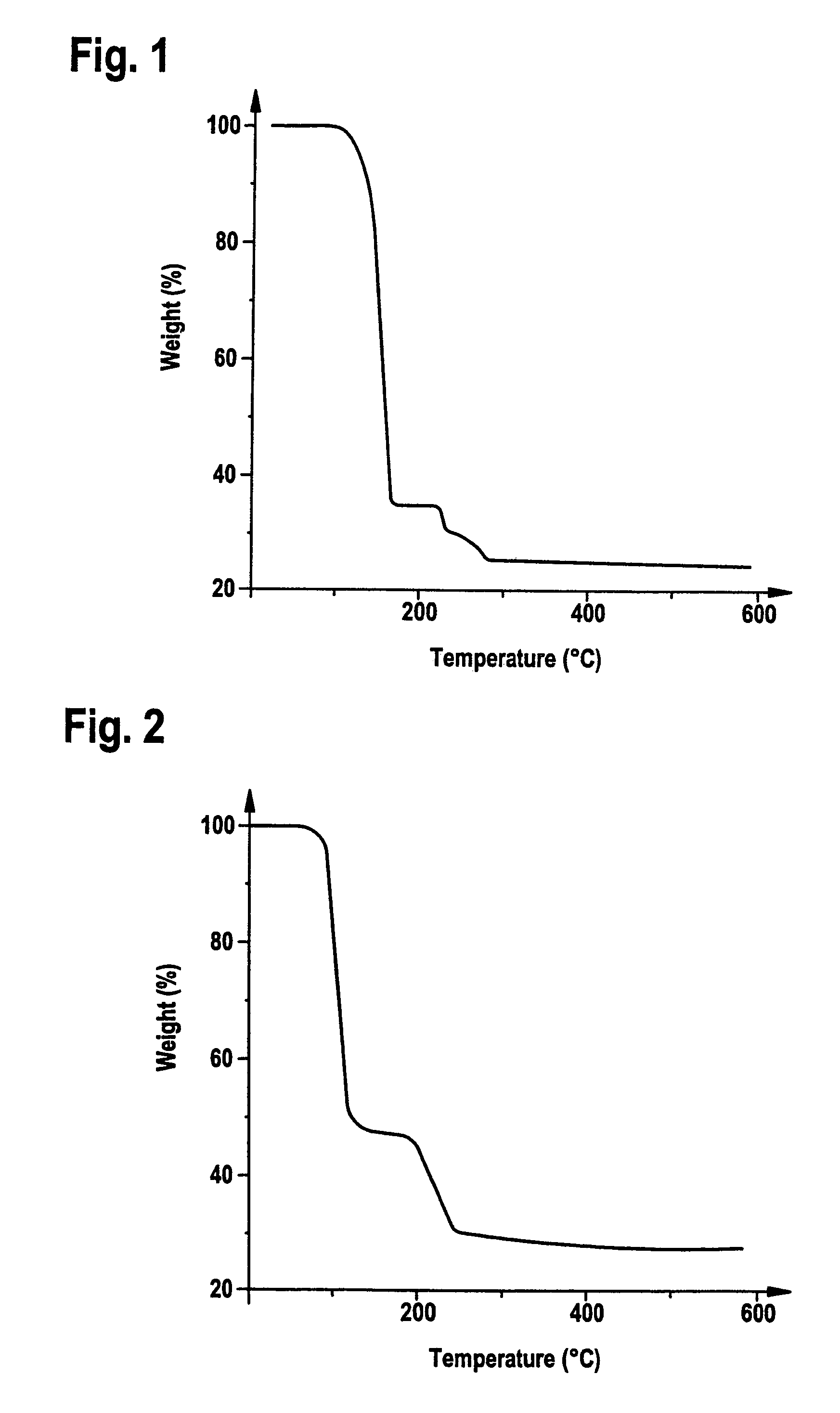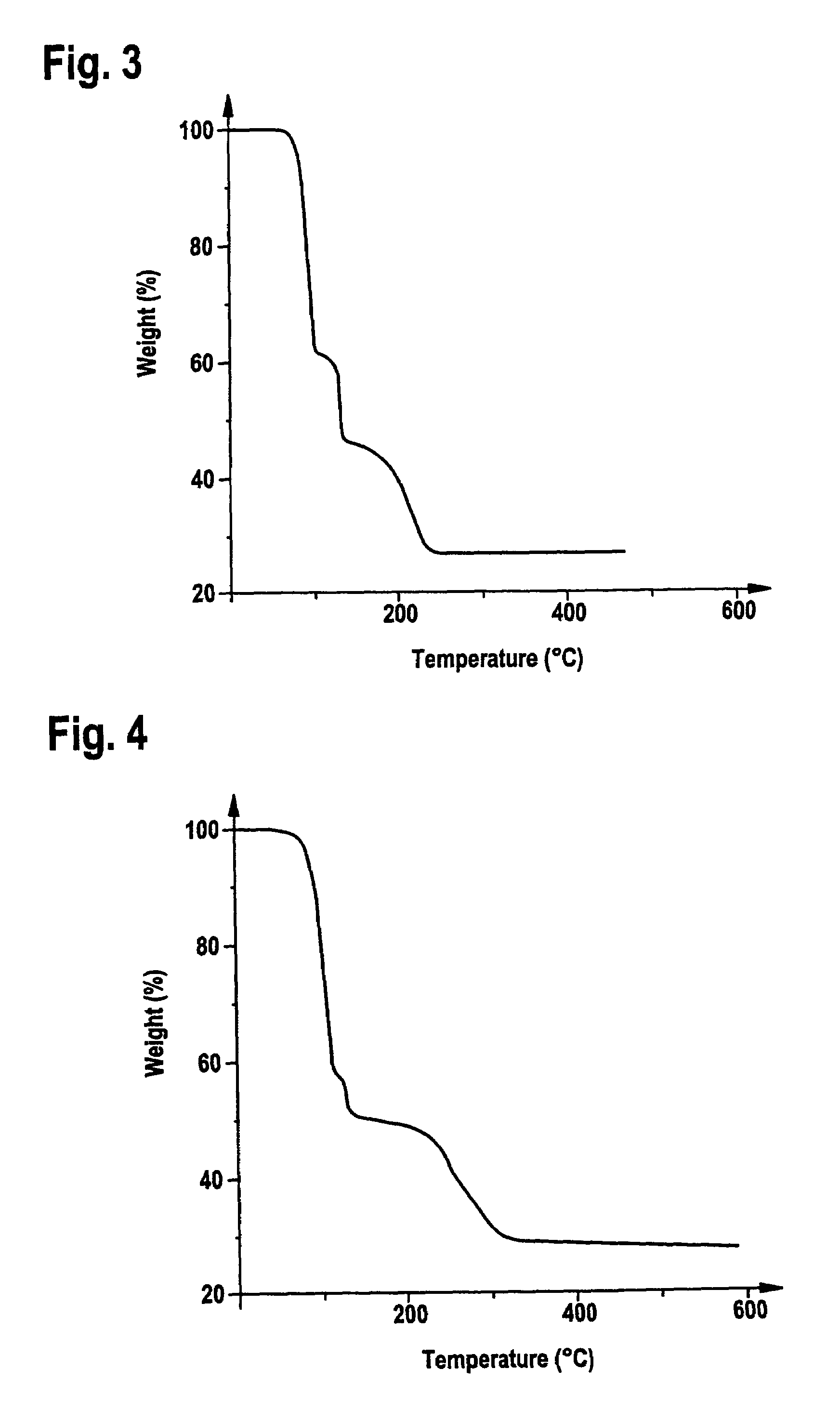Dicopper(I) oxalate complexes for use as precursor substances in metallic copper deposition
a technology of oxalate complexes and copper films, which is applied in the field of oxalate complexes for use as precursor substances in metallic copper deposition, can solve the problems of unusable wafers, imperfect adhesion of copper films to various substrate surfaces, and no longer suitable precursors for cvd process, etc., and achieve the effect of improving properties
- Summary
- Abstract
- Description
- Claims
- Application Information
AI Technical Summary
Benefits of technology
Problems solved by technology
Method used
Image
Examples
example 1
Di{[bis(trimethylsilyl)acetylene]copper(I)}oxalate
[0074]8 g of Me3SiC≡CSiMe3 and 2.14 g of oxalic acid are added to a suspension of 3.4 g of Cu2O in 30 ml of methylene chloride under an inert-gas atmosphere, and the mixture is stirred at room temperature for 4 hours. In order to remove insoluble residues, the solution is passed through a frit with silica gel, and the residue is washed twice with methylene chloride on the frit. The colourless solution is evaporated, and colourless crystals of (Me3SiC≡CSiMe3)2Cu2O4C2 are obtained at −30° C.
[0075]C18H36Cu2O4Si4 (555.92 g / mol). Analysis [%]: calculated: C 38.9, H 6.5, found: C 38.7, H 6.6. IR (KBr) [cm−1]: νC≡C 1935, νCO2 1642, 1354, 1309. 1H-NMR (CDCl3) [ppm]: 0.30 (s, 36H, SiMe3). 13C-NMR (CDCl3) [ppm]: 0.0 (SiMe3), 114.2 (C≡C), 171.8 (CO2). MS (m / e (%)): 788 (25) [M+Cu(Me3SiC≡CSiMe3)]+, 618 (10) [M+Cu]+, 403 (68) [M−CuO4C2]+,233 (100) [M−(Me3SiC≡CSiMe3)CuO4C2]+. TG (30–1000° C., 5° C. / min) two-step decomposition, 1st step temperature...
example 2
Di{[(trimethylsilyl)(n-butyl)acetylene]copper(I)}oxalate
[0078]5 ml of Me3SiC≡CnBu and 1.13 g of oxalic acid are added to a suspension of 1.8 g of Cu2O in 400 ml of methylene chloride under an inert-gas atmosphere, and the mixture is stirred at room temperature for 5 hours. In order to remove insoluble residues, the solution is passed through a frit with silica gel, and the residue is washed twice with methylene chloride on the frit. The colourless solution is evaporated, and colourless crystals of (Me3SiC≡CnBu)2Cu2O4C2 are obtained at −30° C.
[0079]C20H36Cu2O4Si2 (523.77 g / mol). IR (KBr) [cm−1]: νC≡C 1986, νCO2 1643, 1355, 1311. 1H-NMR (CDCl3) [ppm]: 0.29 (s, 18H, SiMe3), 0.93 [t, 3JHH=7.0 Hz, 6H, (CH2)3CH3], 1.3–1.6 [m, 4H, (CH2)2CH2CH3], 1.5–1.8 (m, 4H, CH2CH2CH2CH3), 2.58 [t, 3JHH=7.0 Hz, 4H, CH2(CH2)2Ch3]. 13C—(CDCl3) [ppm]: 0.0 (SiMe3), 13.4 [(CH2)3CH3], 21.7 [(CH2)2CH2CH3], 22.5 (CH2CH2CH2CH3), 30.9 (≡CCH2), 85.4 (≡CCH2), 112.9 (SiC≡C), 171.4 (CO2). MS (m / e (%)): 741 (20) [M+Cu...
example 3
Di[(vinyl-t-butyldimethylsilane)copper(I)]oxalate
[0082]4.8 ml of H2C═CHSiMe2tBu and 1.13 g of oxalic acid are added to a suspension of 1.8 g of Cu2O in 400 ml of methylene chloride under an inert-gas atmosphere, and the mixture is stirred at room temperature for 5 hours. In order to remove insoluble residues, the solution is passed through a frit with silica gel, and the residue is washed twice with methylene chloride on the frit. The colourless solution is evaporated, and colourless crystals of (H2C═CHSiMe2tBu)2Cu2O4C2 are obtained at −30° C.
[0083]C18H36Cu2O4Si2 (499.75 g / mol). IR (KBr) [cm−1]: νCO2 1647, 1344, 1312. 1H-NMR (CDCl3) [ppm]: 0.14 (s, 12H, Si(CH3)2), 0.90 (s, 18H, C(CH3)3), 4.50 (dd, Jtrans=18.3 Hz, Jgem=2.5 Hz, 2H, SiCH═CH2), 4.78 (dd, Jtrans=18.3 Hz, Jcis=13.3 Hz, 2H, SiCH═CH2), 4.86 (dd, Jcis=13.3 Hz, Jgem=2.5 Hz, 2H, SiCH═CH2). 13C-NMR (CDCl3) [ppm]: −5.8 (SiMe2), 16.8 (CMe3), 26.2 (CMe3), 91.0 (═CH2), 97.4 (═CHSi), 171.6 (CO2). MS (m / e (%)): 347 (62) [M−CUO4C2]+, ...
PUM
| Property | Measurement | Unit |
|---|---|---|
| temperature | aaaaa | aaaaa |
| temperature | aaaaa | aaaaa |
| temperature | aaaaa | aaaaa |
Abstract
Description
Claims
Application Information
 Login to View More
Login to View More - R&D
- Intellectual Property
- Life Sciences
- Materials
- Tech Scout
- Unparalleled Data Quality
- Higher Quality Content
- 60% Fewer Hallucinations
Browse by: Latest US Patents, China's latest patents, Technical Efficacy Thesaurus, Application Domain, Technology Topic, Popular Technical Reports.
© 2025 PatSnap. All rights reserved.Legal|Privacy policy|Modern Slavery Act Transparency Statement|Sitemap|About US| Contact US: help@patsnap.com



